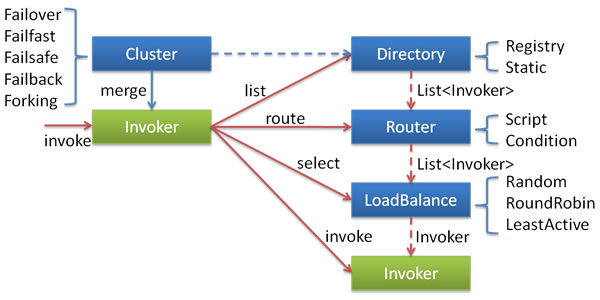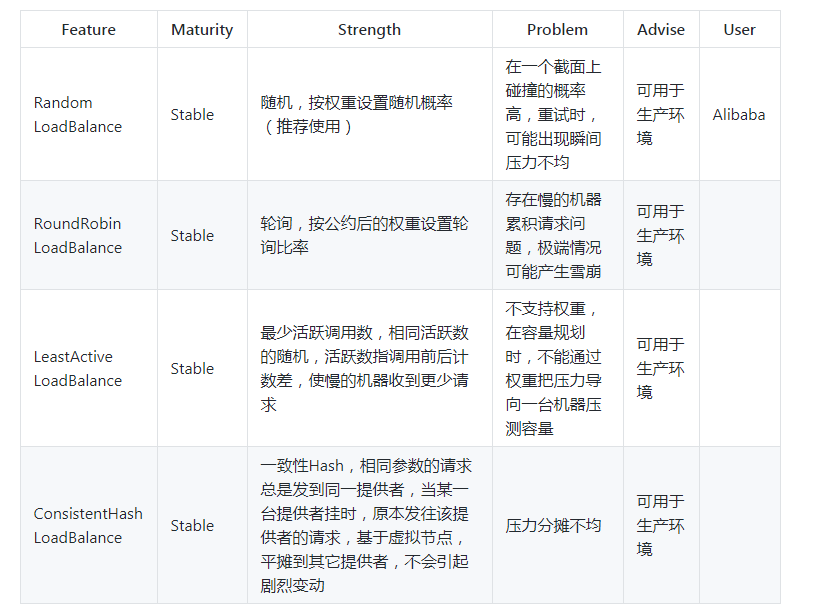部分描述来自官方文档,本文加以润色,半原创
集群概述
我们先来看一下集群的作用 :
为了处理这些问题,Dubbo 定义了集群接口 Cluster 以及 Cluster Invoker。集群 Cluster 用途是将多个服务提供者合并为一个 Cluster Invoker,并将这个 Invoker 暴露给服务消费者。这样一来,服务消费者只需通过这个 Invoker 进行远程调用即可,至于具体调用哪个服务提供者,以及调用失败后如何处理等问题,现在都交给集群模块去处理。集群模块是服务提供者和服务消费者的中间层,为服务消费者屏蔽了服务提供者的情况,这样服务消费者就可以专心处理远程调用相关事宜。比如发请求,接受服务提供者返回的数据等。这就是集群的作用。
集群容错包含多个组件 : Cluster , Cluster Invoker , Directory , Router 和 LoadBalance 等,工作过程如下 :
分为两个阶段 :
- 在服务消费者初始化期间,集群 Cluster 实现类为服务消费者创建 Cluster Invoker 实例,即上图中的 merge 操作。
- 在服务消费者进行远程调用时,经过路由,负载均衡等组件返回最终的 Invoker ,并调用最终的invoke 方法 。
dubbo 提供以下几种对于 fail 的处理 。
源码分析
分析之前我们先要知道Cluster invoker 和 Cluster 的区别,后者是个接口,而前面只是 invoker 一种实现。 Cluster 接口,可以看到该接口只有一个方法,目的很明确就是生成 invoker .
@SPI(FailoverCluster.NAME)
public interface Cluster {
/**
* Merge the directory invokers to a virtual invoker.
*
* @param <T>
* @param directory
* @return cluster invoker
* @throws RpcException
*/
@Adaptive
<T> Invoker<T> join(Directory<T> directory) throws RpcException;
}
下面看一下 Cluster 的实现类。
public class FailoverCluster extends AbstractCluster {
public final static String NAME = "failover";
@Override
public <T> AbstractClusterInvoker<T> doJoin(Directory<T> directory) throws RpcException {
return new FailoverClusterInvoker<>(directory);
}
}
public abstract class AbstractCluster implements Cluster {
// 最终返回的对象是 InterceptorInvokerNode ,该类是内部类,定义在下面
private <T> Invoker<T> buildClusterInterceptors(AbstractClusterInvoker<T> clusterInvoker, String key) {
AbstractClusterInvoker<T> last = clusterInvoker;
List<ClusterInterceptor> interceptors = ExtensionLoader.getExtensionLoader(ClusterInterceptor.class).getActivateExtension(clusterInvoker.getUrl(), key);
if (!interceptors.isEmpty()) {
for (int i = interceptors.size() - 1; i >= 0; i--) {
final ClusterInterceptor interceptor = interceptors.get(i);
final AbstractClusterInvoker<T> next = last;
last = new InterceptorInvokerNode<>(clusterInvoker, interceptor, next);
}
}
return last;
}
// Directory 指的是上节的服务字典(保存着privider的各种信息)
@Override
public <T> Invoker<T> join(Directory<T> directory) throws RpcException {
return buildClusterInterceptors(doJoin(directory), directory.getUrl().getParameter(REFERENCE_INTERCEPTOR_KEY));
}
//子类实现
protected abstract <T> AbstractClusterInvoker<T> doJoin(Directory<T> directory) throws RpcException;
//内部类
protected class InterceptorInvokerNode<T> extends AbstractClusterInvoker<T> {
@Override
public Result invoke(Invocation invocation) throws RpcException {
Result asyncResult;
try {
//before方法
interceptor.before(next, invocation);
//执行
asyncResult = interceptor.intercept(next, invocation);
} catch (Exception e) {
// onError callback
if (interceptor instanceof ClusterInterceptor.Listener) {
ClusterInterceptor.Listener listener = (ClusterInterceptor.Listener) interceptor;
listener.onError(e, clusterInvoker, invocation);
}
throw e;
} finally {
//最终会执行 after 方法
interceptor.after(next, invocation);
}
return asyncResult.whenCompleteWithContext((r, t) -> {
// onResponse callback
if (interceptor instanceof ClusterInterceptor.Listener) {
ClusterInterceptor.Listener listener = (ClusterInterceptor.Listener) interceptor;
if (t == null) {
listener.onMessage(r, clusterInvoker, invocation);
} else {
listener.onError(t, clusterInvoker, invocation);
}
}
});
}
...
}
}
可以看到 AbstractCluster 很巧妙地把返回 invoker 的操作留给子类实现,然后调用 buildClusterInterceptors 方法返回一个经过封装带有拦截器的 invoker 子类,我们可以看到该 invoker 的 invoke 方法出现的 before 和 after 钩子函数,就像 Spring 的切面编程,从而实现拦截器的功能。
ok,下面就看一下 cluster Invoker 的实现。
Cluster Invoker 源码分析
前面说过,集群工作过程可分为两个阶段,第一个阶段是在服务消费者初始化期间,这个在服务引用那篇文章中分析过,就不赘述。第二个阶段是在服务消费者进行远程调用时,此时 AbstractClusterInvoker 的 invoke 方法会被调用。列举 Invoker,负载均衡等操作均会在此阶段被执行。因此下面先来看一下 invoke 方法的逻辑。
public abstract class AbstractClusterInvoker<T> implements Invoker<T> {
@Override
public Result invoke(final Invocation invocation) throws RpcException {
checkWhetherDestroyed();
// 绑定 attachments 到 invocation 中.
// binding attachments into invocation.
Map<String, Object> contextAttachments = RpcContext.getContext().getAttachments();
if (contextAttachments != null && contextAttachments.size() != 0) {
((RpcInvocation) invocation).addAttachments(contextAttachments);
}
//可用的 invokers 取出来
List<Invoker<T>> invokers = list(invocation);
//负载均衡选择
LoadBalance loadbalance = initLoadBalance(invokers, invocation);
RpcUtils.attachInvocationIdIfAsync(getUrl(), invocation);
//子类方法实现
return doInvoke(invocation, invokers, loadbalance);
}
...
protected abstract Result doInvoke(Invocation invocation, List<Invoker<T>> invokers,
LoadBalance loadbalance) throws RpcException;
}
================================================================
// FailoverClusterInvoker 的 doInvoke 方法实现
@Override
@SuppressWarnings({"unchecked", "rawtypes"})
public Result doInvoke(Invocation invocation, final List<Invoker<T>> invokers, LoadBalance loadbalance) throws RpcException {
List<Invoker<T>> copyInvokers = invokers;
checkInvokers(copyInvokers, invocation);
String methodName = RpcUtils.getMethodName(invocation);
int len = getUrl().getMethodParameter(methodName, RETRIES_KEY, DEFAULT_RETRIES) + 1;
if (len <= 0) {
len = 1;
}
// retry loop.
RpcException le = null; // last exception.
List<Invoker<T>> invoked = new ArrayList<Invoker<T>>(copyInvokers.size()); // invoked invokers.
Set<String> providers = new HashSet<String>(len);
// for 重试
for (int i = 0; i < len; i++) {
//Reselect before retry to avoid a change of candidate `invokers`.
//NOTE: if `invokers` changed, then `invoked` also lose accuracy.
if (i > 0) {
checkWhetherDestroyed();
copyInvokers = list(invocation);
// check again
checkInvokers(copyInvokers, invocation);
}
//选择最终的 invoker , select 定义在父类中
Invoker<T> invoker = select(loadbalance, invocation, copyInvokers, invoked);
invoked.add(invoker);
RpcContext.getContext().setInvokers((List) invoked);
try {
//最终调用
Result result = invoker.invoke(invocation);
if (le != null && logger.isWarnEnabled()) {
logger.warn("Although retry the method " + methodName
+ " in the service " + getInterface().getName()
+ " was successful by the provider " + invoker.getUrl().getAddress()
+ ", but there have been failed providers " + providers
+ " (" + providers.size() + "/" + copyInvokers.size()
+ ") from the registry " + directory.getUrl().getAddress()
+ " on the consumer " + NetUtils.getLocalHost()
+ " using the dubbo version " + Version.getVersion() + ". Last error is: "
+ le.getMessage(), le);
}
return result;
} catch (RpcException e) {
if (e.isBiz()) { // biz exception.
throw e;
}
le = e;
} catch (Throwable e) {
le = new RpcException(e.getMessage(), e);
} finally {
//记录提供者信息,以便抛出异常可以排查
providers.add(invoker.getUrl().getAddress());
}
}
throw new RpcException(le.getCode(), "Failed to invoke the method "
+ methodName + " in the service " + getInterface().getName()
+ ". Tried " + len + " times of the providers " + providers
+ " (" + providers.size() + "/" + copyInvokers.size()
+ ") from the registry " + directory.getUrl().getAddress()
+ " on the consumer " + NetUtils.getLocalHost() + " using the dubbo version "
+ Version.getVersion() + ". Last error is: "
+ le.getMessage(), le.getCause() != null ? le.getCause() : le);
}
这里我们知道了大概的思路,虽然 FailoverClusterInvoker 也叫 invoker , 但是最终可以远程调用的 invoker 是在 Directory (服务字典)中, FailoverClusterInvoker 只是做了个封装。
我们看一下父类的 select 方法是如何实现获取最终的 invoker 的 。
protected Invoker<T> select(LoadBalance loadbalance, Invocation invocation,
List<Invoker<T>> invokers, List<Invoker<T>> selected) throws RpcException {
if (CollectionUtils.isEmpty(invokers)) {
return null;
}
String methodName = invocation == null ? StringUtils.EMPTY_STRING : invocation.getMethodName();
boolean sticky = invokers.get(0).getUrl()
.getMethodParameter(methodName, CLUSTER_STICKY_KEY, DEFAULT_CLUSTER_STICKY);
//ignore overloaded method
if (stickyInvoker != null && !invokers.contains(stickyInvoker)) {
stickyInvoker = null;
}
//ignore concurrency problem
if (sticky && stickyInvoker != null && (selected == null || !selected.contains(stickyInvoker))) {
if (availablecheck && stickyInvoker.isAvailable()) {
return stickyInvoker;
}
}
Invoker<T> invoker = doSelect(loadbalance, invocation, invokers, selected);
if (sticky) {
stickyInvoker = invoker;
}
return invoker;
}
private Invoker<T> doSelect(LoadBalance loadbalance, Invocation invocation,
List<Invoker<T>> invokers, List<Invoker<T>> selected) throws RpcException {
if (CollectionUtils.isEmpty(invokers)) {
return null;
}
if (invokers.size() == 1) {
return invokers.get(0);
}
// 调用 loadbalance 的 select 方法
Invoker<T> invoker = loadbalance.select(invokers, getUrl(), invocation);
//If the `invoker` is in the `selected` or invoker is unavailable && availablecheck is true, reselect.
if ((selected != null && selected.contains(invoker))
|| (!invoker.isAvailable() && getUrl() != null && availablecheck)) {
try {
//重新选择的逻辑
Invoker<T> rInvoker = reselect(loadbalance, invocation, invokers, selected, availablecheck);
if (rInvoker != null) {
invoker = rInvoker;
} else {
//Check the index of current selected invoker, if it's not the last one, choose the one at index+1.
int index = invokers.indexOf(invoker);
try {
//Avoid collision
invoker = invokers.get((index + 1) % invokers.size());
} catch (Exception e) {
logger.warn(e.getMessage() + " may because invokers list dynamic change, ignore.", e);
}
}
} catch (Throwable t) {
logger.error("cluster reselect fail reason is :" + t.getMessage() + " if can not solve, you can set cluster.availablecheck=false in url", t);
}
}
return invoker;
}
其中 select 方法,主要的目的 :
select 方法的主要逻辑集中在了对粘滞连接特性的支持上。首先是获取 sticky 配置,然后再检测 invokers 列表中是否包含 stickyInvoker,如果不包含,则认为该 stickyInvoker 不可用,此时将其置空。这里的 invokers 列表可以看做是存活着的服务提供者列表,如果这个列表不包含 stickyInvoker,那自然而然的认为 stickyInvoker 挂了,所以置空。如果 stickyInvoker 存在于 invokers 列表中,此时要进行下一项检测 — 检测 selected 中是否包含 stickyInvoker。如果包含的话,说明 stickyInvoker 在此之前没有成功提供服务(但其仍然处于存活状态)。此时我们认为这个服务不可靠,不应该在重试期间内再次被调用,因此这个时候不会返回该 stickyInvoker。如果 selected 不包含 stickyInvoker,此时还需要进行可用性检测,比如检测服务提供者网络连通性等。当可用性检测通过,才可返回 stickyInvoker,否则调用 doSelect 方法选择 Invoker。如果 sticky 为 true,此时会将 doSelect 方法选出的 Invoker 赋值给 stickyInvoker。
接着是分析 doSelect 方法,我们先看一下方法上的注解 :
Select a invoker using loadbalance policy. a) Firstly, select an invoker using loadbalance. If this invoker is in previously selected list, or, if this invoker is unavailable, then continue step b (reselect), otherwise return the first selected invoker b) Reselection, the validation rule for reselection: selected > available. This rule guarantees that the selected invoker has the minimum chance to be one in the previously selected list, and also guarantees this invoker is available.
上面的注解已经说明了该方法执行的逻辑,简单点说就是获取之前一直成功的 invoker ,否则进行 reselect , reselect 过程中会避开之前失败的节点。
FailbackClusterInvoker
@Override
protected Result doInvoke(Invocation invocation, List<Invoker<T>> invokers, LoadBalance loadbalance) throws RpcException {
Invoker<T> invoker = null;
try {
checkInvokers(invokers, invocation);
invoker = select(loadbalance, invocation, invokers, null);
return invoker.invoke(invocation);
} catch (Throwable e) {
logger.error("Failback to invoke method " + invocation.getMethodName() + ", wait for retry in background. Ignored exception: "
+ e.getMessage() + ", ", e);
//失败后,加入一个任务,用于定时重试
addFailed(loadbalance, invocation, invokers, invoker);
return AsyncRpcResult.newDefaultAsyncResult(null, null, invocation); // ignore
}
}
private void addFailed(LoadBalance loadbalance, Invocation invocation, List<Invoker<T>> invokers, Invoker<T> lastInvoker) {
//Timer类
if (failTimer == null) {
synchronized (this) {
if (failTimer == null) {
failTimer = new HashedWheelTimer(
new NamedThreadFactory("failback-cluster-timer", true),
1,
TimeUnit.SECONDS, 32, failbackTasks);
}
}
}
RetryTimerTask retryTimerTask = new RetryTimerTask(loadbalance, invocation, invokers, lastInvoker, retries, RETRY_FAILED_PERIOD);
try {
// 默认 5 秒执行一次
failTimer.newTimeout(retryTimerTask, RETRY_FAILED_PERIOD, TimeUnit.SECONDS);
} catch (Throwable e) {
logger.error("Failback background works error,invocation->" + invocation + ", exception: " + e.getMessage());
}
}
/**
* RetryTimerTask 内部类
*/
private class RetryTimerTask implements TimerTask {
private final Invocation invocation;
private final LoadBalance loadbalance;
private final List<Invoker<T>> invokers;
private final int retries;
private final long tick;
private Invoker<T> lastInvoker;
private int retryTimes = 0;
RetryTimerTask(LoadBalance loadbalance, Invocation invocation, List<Invoker<T>> invokers, Invoker<T> lastInvoker, int retries, long tick) {
this.loadbalance = loadbalance;
this.invocation = invocation;
this.invokers = invokers;
this.retries = retries;
this.tick = tick;
this.lastInvoker=lastInvoker;
}
@Override
public void run(Timeout timeout) {
try {
//重新选择,重新调用
Invoker<T> retryInvoker = select(loadbalance, invocation, invokers, Collections.singletonList(lastInvoker));
lastInvoker = retryInvoker;
retryInvoker.invoke(invocation);
} catch (Throwable e) {
logger.error("Failed retry to invoke method " + invocation.getMethodName() + ", waiting again.", e);
if ((++retryTimes) >= retries) {
logger.error("Failed retry times exceed threshold (" + retries + "), We have to abandon, invocation->" + invocation);
} else {
//重新放入执行
rePut(timeout);
}
}
}
private void rePut(Timeout timeout) {
if (timeout == null) {
return;
}
Timer timer = timeout.timer();
if (timer.isStop() || timeout.isCancelled()) {
return;
}
timer.newTimeout(timeout.task(), tick, TimeUnit.SECONDS);
}
}
FailbackClusterInvoker 利用一个 Timer 去执行重试操作,逻辑没什么复杂的。其他的 invoker 不再分析了。
使用示例
下面展示failback 的集群失败策略。 provider 端
public interface DemoService {
String sayHello(String name) throws Exception;
}
public class DemoServiceImpl implements DemoService {
private static final Logger logger = LoggerFactory.getLogger(DemoServiceImpl.class);
int count = 0 ;
@Override
public String sayHello(String name) throws Exception{
logger.info("Hello " + name + ", request from consumer: " + RpcContext.getContext().getRemoteAddress());
logger.info("我被调用啦 + " + count++);
try {
Thread.sleep(8000);
} catch (InterruptedException e) {
e.printStackTrace();
}
return "Hello " + name + ", response from provider: " + RpcContext.getContext().getLocalAddress();
}
...
}
提供者的配置
<beans xmlns:xsi="http://www.w3.org/2001/XMLSchema-instance"
xmlns:dubbo="http://dubbo.apache.org/schema/dubbo"
xmlns="http://www.springframework.org/schema/beans"
xsi:schemaLocation="http://www.springframework.org/schema/beans http://www.springframework.org/schema/beans/spring-beans-4.3.xsd
http://dubbo.apache.org/schema/dubbo http://dubbo.apache.org/schema/dubbo/dubbo.xsd">
<dubbo:application name="demo-provider"/>
<dubbo:registry address="zookeeper://127.0.0.1:2181"/>
<dubbo:protocol name="dubbo"/>
<bean id="demoService" class="org.apache.dubbo.demo.provider.DemoServiceImpl"/>
<dubbo:service interface="org.apache.dubbo.demo.DemoService" ref="demoService" cluster="failback" />
</beans>
消费端
public class Application {
public static void main(String[] args) throws Exception {
ClassPathXmlApplicationContext context = new ClassPathXmlApplicationContext("spring/dubbo-consumer.xml");
context.start();
try {
DemoService demoService = context.getBean("demoService", DemoService.class);
String s = demoService.sayHello("aaa");
System.out.println("s : " + s);
System.out.println("进入等待 : ");
Thread.sleep(1000 * 50);
} catch (Exception e) {
Thread.sleep(1000 * 50);
}
}
}
然后看一下提供端的日志:
[13/04/20 16:38:30:713 CST] DubboServerHandler-192.168.10.27:20880-thread-2 INFO provider.DemoServiceImpl: Hello aaa, request from consumer: /192.168.10.27:8693 [13/04/20 16:38:30:713 CST] DubboServerHandler-192.168.10.27:20880-thread-2 INFO provider.DemoServiceImpl: 我被调用啦 + 0 [13/04/20 16:38:37:544 CST] DubboServerHandler-192.168.10.27:20880-thread-3 INFO provider.DemoServiceImpl: Hello aaa, request from consumer: /192.168.10.27:8693 [13/04/20 16:38:37:544 CST] DubboServerHandler-192.168.10.27:20880-thread-3 INFO provider.DemoServiceImpl: 我被调用啦 + 1 [13/04/20 16:38:44:544 CST] DubboServerHandler-192.168.10.27:20880-thread-4 INFO provider.DemoServiceImpl: Hello aaa, request from consumer: /192.168.10.27:8693 [13/04/20 16:38:44:544 CST] DubboServerHandler-192.168.10.27:20880-thread-4 INFO provider.DemoServiceImpl: 我被调用啦 + 2 [13/04/20 16:38:51:545 CST] DubboServerHandler-192.168.10.27:20880-thread-5 INFO provider.DemoServiceImpl: Hello aaa, request from consumer: /192.168.10.27:8693 [13/04/20 16:38:51:545 CST] DubboServerHandler-192.168.10.27:20880-thread-5 INFO provider.DemoServiceImpl: 我被调用啦 + 3
我们发现共重试了3次,然后消费者就丢弃了这个调用,不再调用,这种适用于异步消息通知的调用。
总结
dubbo对于集群内调用失败的几种处置方式
参考资料
- https://dubbo.apache.org/zh-cn/blog/dubbo-cluster-error-handling.html

